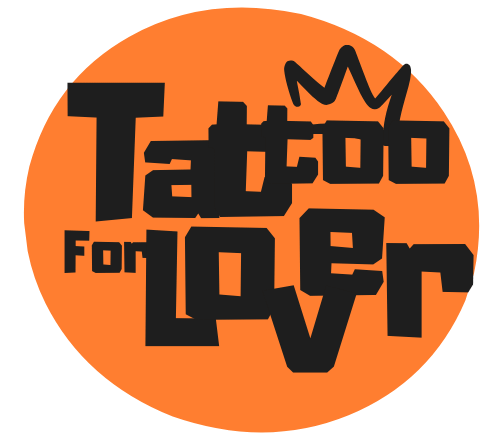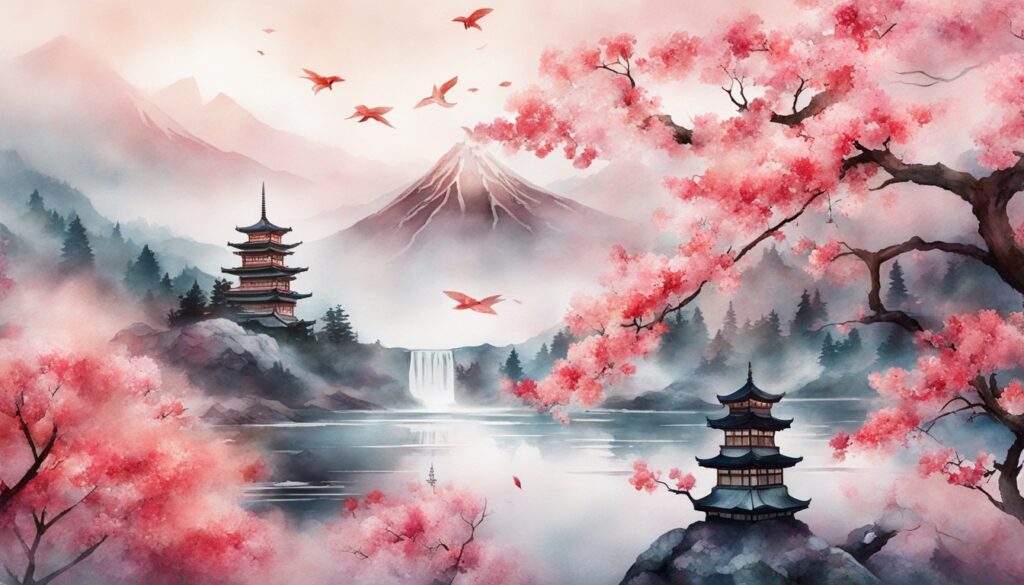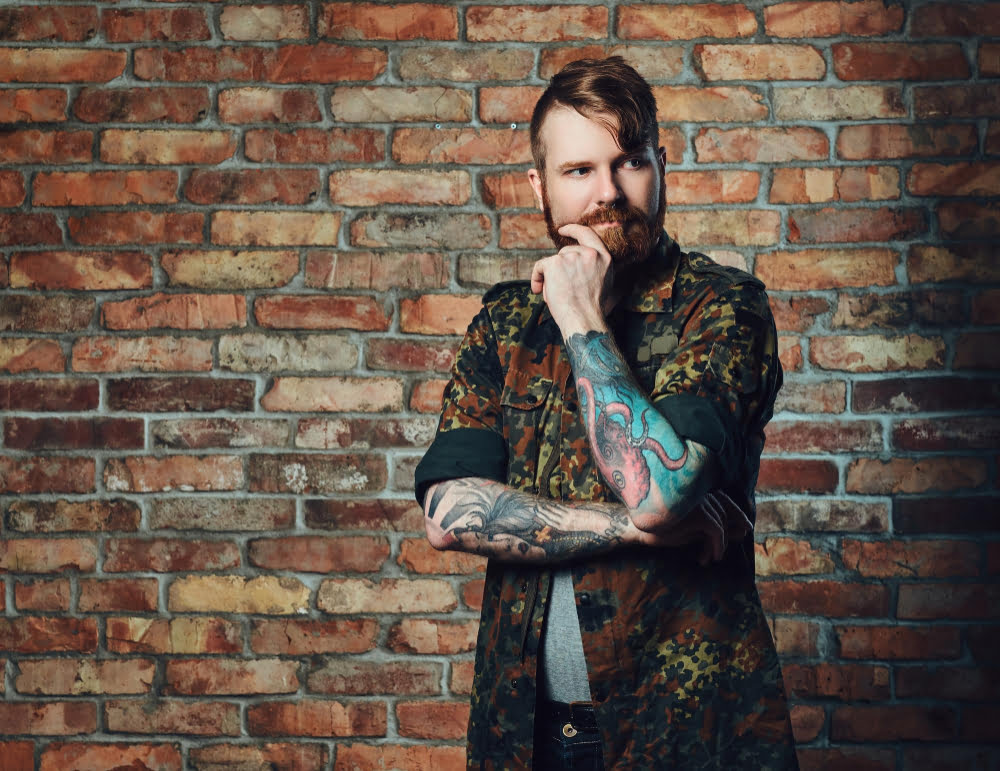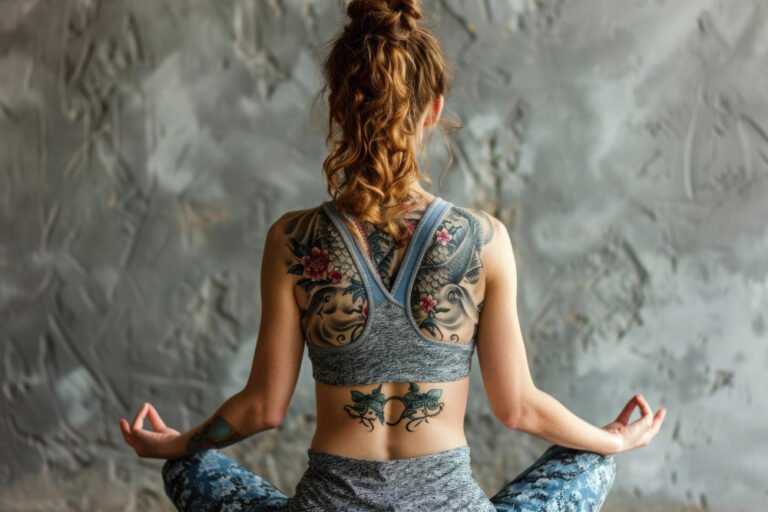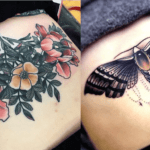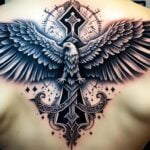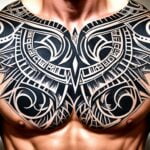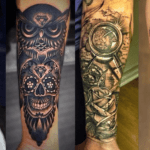The world of tattoo style complexity is always growing. It shows the blend of history and new ideas. From the clear lines of traditional tattoos to the soft colors of watercolor styles, each intricate tattoo design has its own story. Artists like Norman Collins, also known as Sailor Jerry, helped make traditional designs popular for their bold look and lasting appeal.
The wide range of detailed tattoo art lets artists and fans pick styles that speak to them. This creates art that lasts beyond just being in style.
Key Takeaways
- Tattoo style complexity reflects a combination of creative evolution and personal significance.
- Choosing a tattoo style is an introspective process, influenced by personal, artistic, and cultural factors.
- Traditional tattoos often carry the essence of iconic motifs and historical longevity.
- The responsibility of selecting the right tattoo artists is pivotal for achieving a desired artistic vision.
- Watercolor and tribal tattoos cater to distinct philosophies and personality types.
- Tattoo styles can blend into unique designs, symbolizing a harmonious fusion of individuality and aesthetic preference.
The Evolution and Diversity of Tattoo Styles
Tattoo art has changed a lot over the years. It has mixed with different cultures and personal stories. From the deep traditions of Japanese Irezumi to the bold lines of traditional tattoos, each style tells its own story. This change shows how society and what people accept has changed.
The Rise of Traditional Tattooing and Its Pioneers
Traditional tattooing became popular after World War II. It’s known for its bold black lines, bright colors, and symbols like anchors and eagles. Artists like Sailor Jerry made it a big part of American culture, symbolizing freedom and patriotism, especially for the military.
This style was all about clear images that meant a lot to people. It showed personal and shared feelings of the time.
Neo-Traditional and New School: The Modern Take on Classics
Neo-Traditional and New School tattoos started to appear later. They built on traditional American tattoos but added more shading and colors. Neo-Traditional also took inspiration from Art Nouveau and Art Deco.
New School tattoos, known for their cartoon look and bright colors, started in the 1970s. They brought pop culture into traditional tattoos.
Japanese Tattoos and Their Cultural Significance
Japanese Irezumi is a deep and detailed tattoo style. It uses symbols from stories and nature, like koi fish and cherry blossoms. These tattoos are not just for show; they carry deep cultural meaning and stories. They often cover big parts of the body, telling a complete story.
Looking at these tattoo styles shows us more than just art. It’s a way to see how culture has changed over time. The table below shows how tattoos have moved from traditional to modern styles over the years.
| Decade | Traditional Style Popularity | Modern Style Trends |
|---|---|---|
| 1940s | Patriotic and military tattoos | Emergence of large tattoo designs |
| 1970s | Continuation of traditional themes | Beginning of New School tattoo style |
| 1980s | Bright, bold designs | Introduction of vibrant colors in tattoos |
| 1990s | Traditional motifs maintain popularity | Rise of more feminine designs |
| 2000s-present | Revival of Japanese Irezumi and Neo-Traditional | Popularity of delicate outlines and modern aesthetics |
The changing tattoo styles show how art tastes and society’s view of tattoos have evolved. This art form is as ever-changing as the people who get tattoos.
Traditional and Neo-Traditional Tattoos: A Contrast in Aesthetics
The world of tattoos is full of styles, each with its own history and look. American Traditional tattoos and Neo-Traditional ink are great examples of Classic tattoo style with a modern twist.
American Traditional tattoos have a long history. They use bold lines and bright colors like reds, yellows, and blues. This style started in the late 19th century, thanks to artists like Norman “Sailor Jerry” Collins. He was known for his bold style and artistic skill.
Defining Features of American Traditional Tattoos
American Traditional tattoos are known for their bold lines and bright colors. You’ll often see symbols like eagles, anchors, and skulls. These symbols stand for bravery, freedom, and the shortness of life.
This style is loved for its simple shading and big impact. It’s a timeless choice in the tattoo world.
The Artistic Nuances of Neo-Traditional Ink
Neo-Traditional ink takes the classic style further with more colors and themes. It started in the late 20th century. Neo-Traditional tattoos use bright colors and detailed designs. This lets artists show both old and new subjects in a new way.
This style mixes traditional symbols with pop culture and fantasy. It’s both new and familiar. The bold lines are clear, and the colors and shading show great skill and artistic nuances. This meets today’s love for bold and detailed tattoos.
In the end, American Traditional tattoos and Neo-Traditional tattoos add to tattooing’s rich history and beauty. They tell stories and evolve with art. Through Neo-Traditional tattoos, tattoos continue to grow and inspire, leaving their mark on people and art history.
Brilliance in Simplicity: Minimalist and Geometric Tattoos
The Minimalist tattoo style and Geometric tattoos are modern takes on ancient inking traditions. They show deep meanings through simple designs. An apprenticeship program at Ink Different Tattoo shows how these styles are elegant and deep.
Key Characteristics of Minimalist Design
Minimalist tattoos focus on simple beauty with clean lines and few colors. They are popular for their modern look and deep meaning. They use empty space to tell a story, making viewers think more about the art.
Most people who like minimalist tattoos prefer geometric patterns. These patterns are clear and never go out of style.
Symbolism and Balance in Geometric Ink
Geometric tattoos are known for their balance and deep meanings. They use symbols like triangles, squares, and circles to tell stories. These tattoos mix old beliefs with today’s style, sharing big ideas across different cultures.
Geometric and Minimalist tattoos tell stories with simple shapes and clear lines. They are becoming more popular in places like Brooklyn’s tattoo scene. This shows how art and tattoos can share deep thoughts and feelings.
Exploring the Unique Aspects of Blackwork and Tribal Ink
The Blackwork tattoo style and Tribal tattoos are more than just pretty pictures. They carry deep cultural and historical meanings that grab people’s attention all over the world. Let’s dive into the stark beauty and unique aspects of these art forms.
The Stark Beauty of Blackwork Tattoos
Blackwork tattoos are known for their bold look and simple beauty. They use lots of black ink to make designs that pop and have a deep meaning. These tattoos use thick lines and big black areas, making them feel powerful.
They draw inspiration from Polynesian patterns and Spanish Blackwork embroidery. These designs have abstract motifs that speak to those looking for meaning in their tattoos. Today, Blackwork has branched out into styles like Geometric, Dotwork, and Dark Art, each with its own look but keeping the style’s core essence.
Using black ink makes these tattoos stand out even more. They look great on the skin and last a long time.
The Deep Roots of Tribal Tattooing
Tribal tattoos show the long history of body art in different cultures. They go back to ancient times in Maori, Polynesia, and Europe. Back then, they meant more than just decoration. They were important for life events, protection, or status in the tribe.
Today, Tribal tattoos keep these meanings alive with their detailed patterns and symbols. They use swirls, shapes, and patterns that tell the wearer’s story or show what they feel inside.
Blackwork and Tribal tattoos both value tradition and culture but also let people add their own twist. Whether you like the deep meanings of Tribal art or the bold look of Blackwork, these styles let you express yourself in a lasting way. Artists like Charles Huurman and Thomas Hooper are pushing these styles forward, keeping them fresh while respecting their roots.
Talking about these tattoos shows how they’re not just pretty; they’re also a way to share stories and feelings. As they change, Blackwork and Tribal tattoos keep reminding us of the past, now on our skin.
An Overview of Realism and New School Tattooing Techniques
In the world of tattoos, realism and New School styles stand out. They show how tattooing has grown and deepened. Realism tattoos and New School ink use lifelike designs and colors to tell stories or express personal feelings.
Realism Tattoos: Bringing Images to Life
Realism tattoos aim to capture every detail, making them look like photos or real scenes. They can be in black and gray or full color. The artist’s skill is key to creating depth and contrast without bold lines.
These tattoos can show the fine details of skin or the lively looks of animals. Each piece is like a unique work of art.
Colorful Flair of New School Tattoos
New School tattoos became popular in the late 80s and 90s. They’re known for their bright colors and cartoon-like features. This style uses many colors and bold lines for a 2D effect that stands out.
It draws from graffiti, comics, and video games, showing a modern, bold take on tattoos.
Realism and New School tattoos have deep roots in their histories and cultures. They keep evolving with new tattooing techniques. Here’s a look at how these two styles compare:
| Feature | Realism Tattoos | New School Tattoos |
|---|---|---|
| Color Usage | Black and gray or full color | Vivid, varied palette |
| Design Influence | Real-life objects, people, animals | Cultural icons, cartoons, graffiti |
| Technique Focus | Detail, depth, and shadow | Bold lines, exaggerated forms |
| Historical Emergence | Evolved over 50 years | Originated in the 1980s-1990s |
Juxtaposing the Visual Elements of Japanese and Watercolour Tattoos
The art of tattooing has changed a lot over the years. It has taken on many styles, each with its own deep stories and unique look. Japanese tattoos and Watercolour tattoos are two styles that really stand out. They tell stories through their visuals and use special techniques.
Japanese Tattoos: Complex Narratives through Imagery
Japanese tattoos are known for their strong lines and long history. They go back to Japan’s Edo period. These tattoos often cover big parts of the body. They feature things like dragons, koi fish, and cherry blossoms, which are full of cultural meaning and complex narratives.
This style’s technique, perfected through the irezumi method, wraps the wearer in Japan’s rich folklore and tradition.
Watercolour Tattoos: The Delicate Art of Gradient Coloring
Watercolour tattoos take a softer and more dreamy approach to body art. They look like watercolor paintings. This style uses a mix of colors smoothly, focusing on bright designs and the fine art of gradient coloring.
Even though they’re not as bold as Japanese tattoos, Watercolour tattoos are great at showing feelings and subtle beauty.
| Tattoo Style | Cultural Significance | Main Characteristics | Maintenance Required |
|---|---|---|---|
| Japanese | Deep roots in Edo period art forms and symbols | Wide coverage, bold lines, cultural icons like dragons and koi fish | Low maintenance due to bold lines and darker colors |
| Watercolour | Inspired by contemporary watercolor art | Bright, flowing colors, smooth gradient coloring | Higher maintenance to retain vibrancy |
Both Japanese tattoos and Watercolour tattoos see tattooing as more than just decoration. They’re about telling personal stories and showing who you are. Japanese tattoos go deep into culture and history. Watercolour tattoos capture the lightness and beauty of watercolor paintings.
Even though they’re different, both styles are all about the beauty and stories they bring to life in ink.
Tattoo Style Complexity: Delving into Intricate Design Elements
The art of tattooing offers a wide range of styles, each with detailed ink designs, complex tattoo aesthetics, and intricate design elements. These styles blend tradition with innovation, making each tattoo meaningful and unique.
Modern tattooing requires skill and a deep understanding of what the client wants. This mix of artist skill and client vision makes tattoo styles complex.
| Tattoo Style | Key Features | Cultural Significance |
|---|---|---|
| Blackwork Tattoos | Uses solid black ink for bold designs | Symbolizes strength and clarity |
| Watercolor Tattoos | Features bright colors and fluid designs like paint | Represents freedom, creativity, and emotions |
| Realism Tattoos | Looks like reality with detailed shading | Often for commemoration or celebration |
| Traditional Tattoos | Has bold lines and a limited color palette | Based on maritime traditions and folklore |
| Japanese Tattoos (Irezumi) | Covers large areas with deep symbolism | Rooted in culture, tells various stories |
Each tattoo style has its own unique way of creating art. From realism’s detailed layers to watercolor’s vibrant colors, artists pour their hearts into each piece. These intricate design elements are both technical and personal, making tattoos a special form of art.
Understanding complex tattoo aesthetics means seeing the techniques and cultural backgrounds behind them. Whether it’s traditional’s bold lines or realism’s fine details, each method shows an artist’s skill. This complexity lets artists and fans see the deep creativity in each tattoo.
Modern tattooing combines advanced techniques, client needs, and hygiene. This mix highlights the art’s beauty and the artist’s responsibility. Tattoos keep evolving, driven by creativity and high standards, making each design a lasting work of art.
Examining the Significance and Techniques Behind Ornate Tattoo Patterns
The art of ornate tattoo craftsmanship is more than just body art. It’s a mix of history, culture, and personal stories. These designs are complex and need skill in elaborate tattoo design elements to share their deep meanings. They draw from tribal traditions and neo-traditional styles, telling unique stories.
Neo-traditional tattoos are known for their bold lines and bright colors. Artists like Nikko Hurtado update classic American tattoos with a modern twist. This makes the tattoos appealing to people everywhere.
Japanese neo-traditional tattoos mix old and new with designs like dragons and koi fish. They honor ancient Japanese tattooing traditions but with a modern touch. This mix shows the beauty of ornate tattoo craftsmanship, connecting past and present.
| Style | Inspiration | Key Features |
|---|---|---|
| American Neo-Traditional | Traditional American Tattoos | Bold lines, bright colors |
| Japanese Neo-Traditional | Traditional Japanese Tattoos | Mythical creatures, vibrant colors |
| Blackwork Neo-Traditional | Modern Blackwork and Tradition | Bold black lines, negative space |
Neo-traditional tattoos are getting more popular thanks to social media. Sites like Instagram let artists share their work worldwide. This has inspired many, making classic designs like anchor tattoos more popular and varied.
Elaborate tattoo design elements and significant tattoo patterns like neo-traditional tattoos keep traditional art alive. They honor the past while bringing new ideas to the table. Each tattoo is a blend of respect for tradition, a statement today, and a look towards the future.
The Influence of Cultural Themes in Sophisticated Tattoo Imagery
Tattoos let us show off intricate patterns and sophisticated designs, shaped by cultural stories. They blend cultural themes with modern art, keeping traditions alive and adding beauty to this ancient art form.
From ancient times to now, tattoos tell stories of change and personal expression. Each design has deep cultural meaning, showing off social status, achievements, or spiritual beliefs.
Cultural Significance in Tribal Tattoos
Tribal tattoos are among the oldest and most meaningful cultural designs. They’re not just for looks; they show who someone is and their place in society. These tattoos were once part of important life events, filled with history and deep meaning.
Detailed Aesthetics in Cultural Tattoo Interpretations
Today’s tattoo artists mix old symbols with new styles, making tattoos sophisticated and fresh. They keep the traditional feel but add modern touches. This mix brings together the old and new, creating something beautiful on the body.
| Year | Event | Impact on Tattoo Culture |
|---|---|---|
| 5,000 B.C. | First tattoo records in Japan | Initiation of tattoo practice in early civilizations |
| 500 A.D. | Written tattoo records from History of the Chinese Dynasties | Historical evidence of tattoo existence in scholarly texts |
| 720 A.D. | Tattoos used as punishment | Shift in tattoo perception as punitive measures |
| 1868 | Tattoos outlawed in Japan | Suppression of tattooing due to evolving cultural attitudes |
| 1936-1946 | Complete ban on tattooing in Japan | Cultural and political influences leading to the stigmatization of tattoos |
The table shows how tattoos have changed over time, affected by society and culture. Tattoos have moved from being seen as punishment to symbols of pride. They show how tattoos are a changing, meaningful part of our culture.
Conclusion
Tattoos are a canvas that shows the art of humanity across cultures. Advanced tattoo techniques have made designs more complex. Realism is now the top in tattoo art, showing how far we’ve come.
It’s popular because artists can now make tattoos look very real. They need great drawing skills and know a lot about light and shadow. This makes tattoos look alive.
There are many styles, like traditional and watercolor tattoos. Each style tells a different story. They show how tattoo art has changed but still keeps its true meaning.
People getting tattoos add to the art’s history and growth. They choose styles like blackwork or Japanese designs. Each tattoo adds a special piece to the art’s story.
This journey is about finding your own style and celebrating who you are. It’s a way to show the world your story. Tattoo artists keep this art alive and growing.
FAQ
What defines tattoo style complexity?
How did traditional tattooing originate and who were some of its pioneers?
How do Neo-Traditional tattoos differ from American Traditional tattoos?
What cultural significance do Japanese tattoos hold?
What are the key characteristics of Minimalist tattoos?
How do Geometric tattoos symbolize balance and harmony?
What is unique about Blackwork and Tribal tattoos?
What differentiates Realism tattoos from other styles?
How do Watercolour tattoos mimic the actual painting technique?
Can elaborate tattoo motifs and ornate patterns have cultural significance?
How does cultural heritage influence the aesthetics of a tattoo?
Forhad
Forhad's writing is not just about the artistry of tattoos or the latest trends in the industry; it's an exploration of the deep-rooted connections people have with their tattoos, reflecting personal narratives, cultural histories, and moments of transformation. Through a mix of in-depth features, personal narratives, and insightful analyses, he sheds light on the multifaceted nature of tattooing, revealing the emotional and cultural layers that lie beneath the surface.

